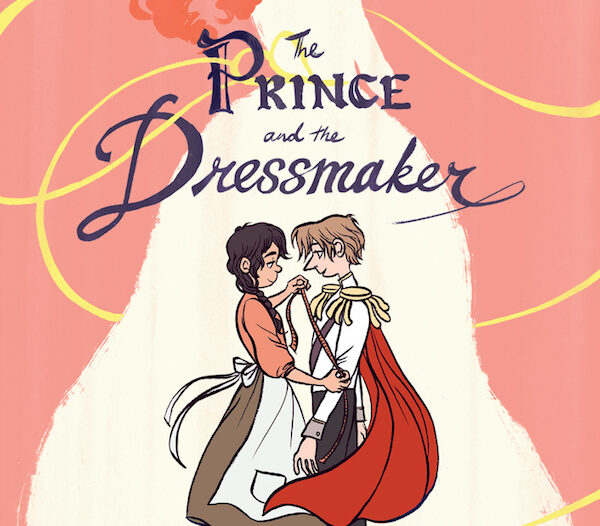
Review: ‘The Prince and The Dressmaker’
The Prince and The Dressmaker
Writer/artist: Jen Wang
First Second; $16.99
Ages 12-18
There is a point late in Jen Wang’s The Prince and The Dressmaker in which Prince Sebastian is at his absolute lowest, his worst fears having been realized, and it genuinely seems like his life as he knew it is over, like perhaps his life itself could even be in serious jeopardy. And then something rather remarkable, and certainly, dramatic happens: His fortunes rather unexpectedly reverse, as some of the same forces that were responsible for his downfall not only learn to accept him, almost overnight, but to even celebrate him.
It doesn’t really seem too terribly realistic, given the 19th century setting. That, however, is a terrible criticism to level at the book, as it hardly seems fair to blame a fairy tale for having an unrealistic, wish-fulfilling, happily-ever-after of an ending.
ADVERTISEMENT
ADVERTISEMENT
And Wang’s book is very much a fairy tale, even opening with a ball being thrown for a handsome young prince, where it is hoped he will find a princess to marry. That prince, in some scenes, even dresses a bit like the Prince Charming of Disney’s Cinderella, with which Wang’s tale has some thematic commonality.
That The Prince and the Dressmaker invites such criticism is actually a credit to it. Wang’s characters are so fully realized, their conflicts and emotions so palpable, and their world so exact, so vital, and so well executed that it’s easy to forget that it is a fairy tale—at least until the happy ending arrives, the first signs of it doing so striking like a lightning bolt. I hesitate to spoil it any more than I already have—the best way to review the book without risking any of its pleasures would be to write a simple, two-word imperative, “Read it”—but when the extent of the acceptance being offered the prince first begins to take shape, it is about as electric and triumphant a moment in a comic book that I can remember.
Prince Sebastian is the Crown Prince of Belgium, and he and his parents the king and queen are staying in Paris for the summer. A ball is being held to celebrate his sixteenth birthday, and his parents are eager for him to find a princess to marry, as he will have to carry on the royal line.
The dressmaker is Frances, one of many seamstresses working at a local dress shop. She is given a last-minute assignment to make a dress for a young woman who wants nothing at all to do with the ball, but is only going because her mother is forcing her to. “You know what, just make it ghastly,” the young woman tells Frances, “Make me look like the devil’s wench.”
Given the license to let her creativity run wild, Frances makes her an outfit that wouldn’t look out of place in a pop music video of today, or on the red carpet of MTV’s VMAs. The dress causes a scandal, but it catches the eye of Sebastian, who engages Frances as his personal dressmaker.
ADVERTISEMENT
ADVERTISEMENT
And why does a prince need a dressmaker? Because Sebastian secretly likes to wear dresses. Not just around the house, but out on the town. With Frances in on his secret, becoming his only real confidant, Sebastian hits the streets of Paris at night as the enigmatic Lady Crystallia, a sensational young woman wearing whatever trend-setting glad rags that Frances has come up with. (If you’re wondering, Sebastian never makes any declarations regarding the way he perceives his gender identity; Frances explains at one point that “This is the way he is,” and that’s as close to any sort of labeling the text gets. Ultimately, the specifics don’t matter all that much in the events of the book, only that the dress-wearing risks alienation and needs acceptance.)
The relationship is beneficial to both of them, and not simply because of their deepening friendship and the blossoming or a romantic attraction between the young pair. Sebastian has a constant supply of amazing dresses, and Frances has a patron/model with deep enough pockets to allow her to realize all of her creative imperatives. There is, of course, a hitch, and it comes when Frances realizes that because she has to keep Sebastian’s secret, that means her talents will also have to be kept secret, and she must let several even greater opportunities pass her by…as well as enabling Sebastian as he tries to live a secret double life.
It all comes to a head, as it inevitably must, but, because this is a fairy tale, it can still end happily. And it does end happily—thoroughly, surprisingly, thrillingly happily.
The year is obviously still quite young, so saying The Prince and The Dressmaker is one of the year’s best might not mean so much here in March as it would in November. But if 2018 produces just a handful of other books as good as this, then it will be an incredible year for comics indeed.
Filed under: Graphic Novels, Reviews, Young Adult
About J. Caleb Mozzocco
J. Caleb Mozzocco is a way-too-busy freelance writer who has written about comics for online and print venues for a rather long time now. He currently contributes to Comic Book Resources' Robot 6 blog and ComicsAlliance, and maintains his own daily-ish blog at EveryDayIsLikeWednesday.blogspot.com. He lives in northeast Ohio, where he works as a circulation clerk at a public library by day.
ADVERTISEMENT
ADVERTISEMENT
SLJ Blog Network
2024 Books from Coretta Scott King Winners
The Ultimate Love Letter to the King of Fruits: We’re Talking Mango Memories with Sita Singh
Parsing Religion in Public Schools
The Tortured Poets Department Poetry Party Part 2: DIY Frames for Your Instant Photos
ADVERTISEMENT








